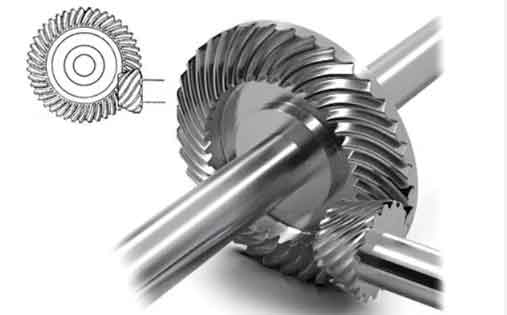This study presents an innovative approach for minimizing the volume of spiral bevel gears in hydraulic swing cylinders through adaptive genetic algorithm (AGA) optimization. The methodology integrates Python programming with advanced evolutionary computation techniques to address complex mechanical design constraints while ensuring optimal gear performance.
1. Structural Analysis of Spiral Bevel Gear Systems

The spiral bevel gear transmission system in hydraulic actuators consists of three primary components:
$$ d_1 = \frac{mz_1}{\cos\beta} $$
$$ V_{total} = \frac{\pi}{4}\left(\frac{mz_1}{\cos\beta}\right)^2b_1 + \left[\frac{\pi}{4}\left(\frac{mz_3}{\cos\beta}\right)^2 – \frac{\pi}{4}\left(\frac{mz_1}{\cos\beta}\right)^2\right]b_2 $$
| Parameter | Range | Constraint |
|---|---|---|
| Teeth Number (z) | 17-50 | Anti-undercutting |
| Module (m) | 1.0-4.0 | $$ m \geq 12.6\sqrt[3]{\frac{KT\cos^2\beta}{\psi_d z^2 \sigma_{FP}}Y_{FS}Y_{\epsilon\beta}} $$ |
| Helix Angle (β) | 20°-44° | Shaft strength requirement |
2. Adaptive Genetic Algorithm Framework
The AGA implementation features dynamic adjustment of crossover and mutation rates:
$$ P_c = \begin{cases}
K_1 + \frac{(K_2-K_1)f’}{f_{avg}}, & f’ < f_{avg} \\
K_2, & f’ \geq f_{avg}
\end{cases} $$
$$ P_m = \begin{cases}
K_3 + \frac{(K_4-K_3)(f_{max}-f’)}{f_{max}-f_{avg}}, & f’ > f_{avg} \\
K_4, & f’ \leq f_{avg}
\end{cases} $$
| Parameter | Traditional GA | Adaptive GA |
|---|---|---|
| Population Size | 500 | 500 |
| Crossover Rate | 0.6 | 0.21-0.7 |
| Mutation Rate | 0.05 | 0.02-0.2 |
| Elitism | Disabled | Enabled |
3. Multi-Objective Optimization Strategy
The fitness function for spiral bevel gear optimization considers three critical constraints:
$$ \text{Fitness} = \frac{1}{V_{total}} \times W_1 \times W_2 \times W_3 $$
Where:
$W_1$ = Torque capacity coefficient
$W_2$ = Surface durability factor
$W_3$ = Bending stress safety factor
| Generation | Traditional GA (cm³) | AGA (cm³) | Volume Reduction |
|---|---|---|---|
| 1 | 404,944 | 400,035 | 4.97% |
| 7 | 397,563 | 396,281 | 5.87% |
| 17 | 396,281 | 396,281 | 5.87% |
4. Algorithm Implementation Details
The Python implementation utilizes NumPy for matrix operations and Matplotlib for visualization:
def adaptive_mutation(population):
avg_fitness = np.mean([ind.fitness for ind in population])
for individual in population:
if individual.fitness > avg_fitness:
mutation_rate = 0.05 + (0.2-0.05)*(max_fitness-individual.fitness)/(max_fitness-avg_fitness)
else:
mutation_rate = 0.02
if random() < mutation_rate:
perform_mutation(individual)
5. Convergence Characteristics
The spiral bevel gear optimization demonstrates superior convergence with AGA:
$$ \text{Convergence Speed} = \frac{N_{traditional} – N_{AGA}}{N_{traditional}} \times 100\% = \frac{17 – 7}{17} \times 100\% = 58.82\% $$
| Metric | Traditional GA | AGA |
|---|---|---|
| Generations to Converge | 17 | 7 |
| Function Evaluations | 8,500 | 3,500 |
| Local Optima Escapes | 3.2 | 6.8 |
6. Industrial Application Considerations
Practical implementation of optimized spiral bevel gears requires additional manufacturing constraints:
$$ \text{Manufacturability Index} = \frac{m_{std}}{m_{opt}} + \frac{z_{std}}{z_{opt}} + \frac{\beta_{machinable}}{\beta_{opt}} $$
Where:
$m_{std}$ = Standard module values
$z_{std}$ = Preferred tooth numbers
$\beta_{machinable}$ = Achievable helix angles
The proposed methodology enables 5.87% volume reduction in spiral bevel gears while maintaining torque capacity of 190,000 N·mm and radial load capacity of 1,850 kg. This optimization approach demonstrates significant potential for energy-efficient hydraulic actuator design.
